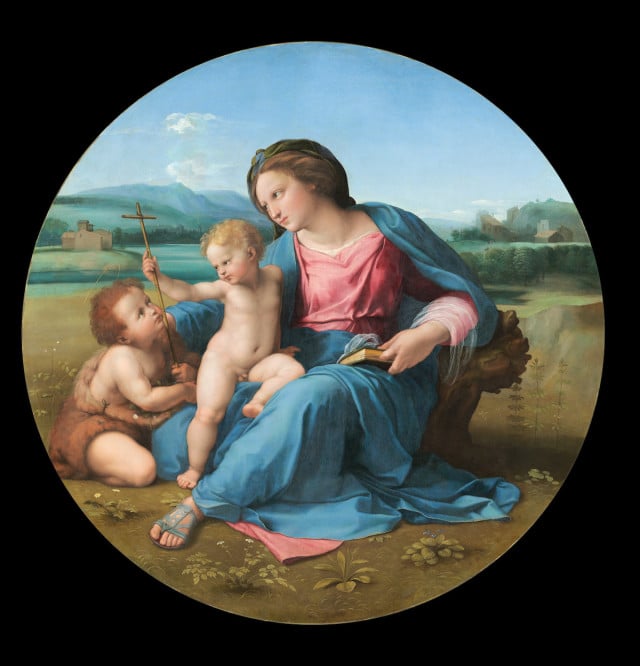
THE DAILY PIC (#1500): Today, the Academy of Non-Motion Picture Arts and Sciences (president: me; total membership: me) is declaring Raphael’s Alba Madonna, painted in around 1510 and now in our National Gallery, to be the single most important work of art in the Western tradition. I’ve chosen it for that honor to mark the arrival of my 1,500th Daily Pic, which over the last five years has found a home every weekday at BlakeGopnik.com and then also at the Washington Post, The Daily Beast, Art Info and now artnet News. In all, the column has totaled up to somewhere near 500,000 words devoted exclusively to the contemplation and analysis of works of art.
I’ve chosen the Alba Madonna as number 1500 because it can pretty much stand for all 1,499 pieces that I featured before it.
Once Raphael comes up with his impeccable, utterly coherent composition – or at least a composition that wants to convince us that it’s impeccable and unalterable – all the art that comes after stands as a reaction to it. All later works, whether they know it or not, are either trying to match it or top it or utterly undermine and tear apart its achievement. The one thing they can’t do is ignore its claim to rise to the highest heights. The Alba Madonna throws down a gauntlet that’s always there to be taken up; refusing the duel is almost the same gesture as fighting it.
And one of the singular achievements of Raphael’s painting, at the very heart of everything that comes after, is the very notion of achievement – of moving art up and forward and into something new and excellent. So even though the Alba Madonna sets itself up as a towering, unchangeable and immoveable triumph – the Mount Everest of art – it also stands for the entire idea of an ever-moving, ever-striving avant-garde, which has been at play for all art and artists over the 500 years since. Picasso’s greatest, most drastic experiments – I had the Demoiselles d’Avignon as a runner up for today’s top spot – are just an elaboration on the fundamental principal of radical creation that the Alba Madonna stands for. Dig deep enough into the videos of a Ryan Trecartin, and you find Raphael’s Madonna peering out at you.
And one way that this Madonna achieves all that is by standing – or I should say sitting – for all the rest of us. Although we can’t ignore Mary’s status as Renaissance Christianity’s Queen of Heaven, we also have to recognize how Raphael brings his deity very literally down to earth. For centuries, Western art has been about the objects humans make and how human viewers react to them. (Let’s call that the perceptual turn). Raphael’s painting captures and exemplifies this idea, by depicting a literally grounded human as the anchor to a painting’s centrifugal forces. It represents humanity as the sun that all art orbits around. You can imagine a Byzantine icon retaining its essential meaning even if every human were gone from Earth. (Or you can imagine a Byzantine priest imagining such a thing.) It’s hard to envision Raphael’s Alba Madonna, or any work since, managing the same post-human trick.
And here’s something about this 500-year-old painting that brings it utterly up to date: It depicts its archetypal, representative human sitting on a earthen plane that extends without interruption in every direction, as though she has ownership of an entire planet that is entirely knowable. And isn’t that precisely where humanity’s sense of self sits today, to our peril?
In a recent conversation with my friend the art historian Alexander Nagel, we were batting around his idea that the discovery of the New World, all of a decade old when Raphael was painting, utterly changed the relationship humans had to their reality, almost the way fire or agriculture or writing did. All of the sudden, everything in the world became knowable and ownable, to anyone with a decent boat. I have some sense that it was that certainty, rather than a few primitive guns, that led a handful of Europeans to conquer the great pre-Columbian empires, and then extend their sway over an entire planet, including its oceans and atmosphere.
Is it an accident that today’s Best Picture achieves its success by taking the shape of a geographer’s globe? That was a technology that was just coming of age when Raphael was painting his picture; almost at once, the globe’s surface was made to include the New World.
So my idea that the Alba Madonna rules over everything isn’t just mine. It’s something the painting itself wants to prove.
For a full survey of past Daily Pics visit blakegopnik.com/archive.